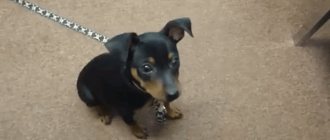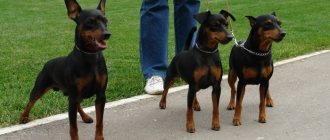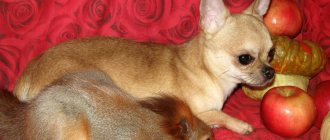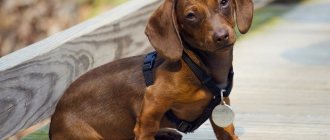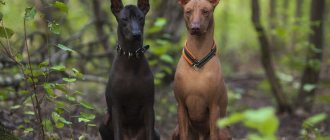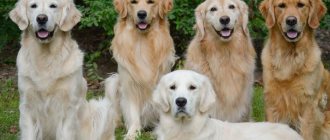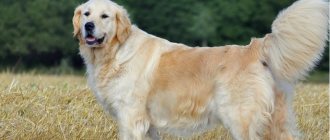When you hear the words “miniature pinscher,” many people think of a small dog. However, not everyone knows what good security qualities it contains. This is a very loyal, cheerful and active dog, gets along well with children. Having chosen a miniature pinscher, you can be sure that this dog has all the makings of an aristocrat. She will become a faithful companion for many years.
History of the breed
Back in the 15th century, it was known about pinscher babies. The birthplace of this breed has been established in Württemberg, Germany. They were housed in stables, where miniature pinschers caught rats and scared thieves with their ringing barks. According to scientists, such dogs appeared much earlier, but no reliable sources of information have been found. Subsequently, they began to be kept in houses; hunters often took miniature pinschers to hunt small game. In the 19th century, the nobility became interested in them.
In 1836 the breed received its modern name. Dog handlers became interested in them. The appearance was the same as the modern one, but the number of wool colors was much greater. In 1880, a standard was fixed and the Miniature Pinscher dog breed received official recognition. These dogs are also known as Fox Pinscher.
Body structure
According to the international classification, these dogs are classified as mastiffs, a group of schnauzers and pinschers. They are famous for their very proportionate body. Description of the Miniature Pinscher breed:
- The head is slightly elongated. The muzzle is completely proportional to the skull.
- The eyes have a regular oval shape, usually black or dark brown.
- The nose is almost always black.
- The ears are set high.
- Both the upper and lower jaws are equally well developed; due to this feature, the chewing muscles and scissor bite are clearly visible.
- The neck is quite long, thin and graceful.
- The body is elongated and very fit, the muscles are clearly defined.
- The dog's coat should be short and shiny, lying fairly close to the body.
- The limbs are thin, but very strong. The hind legs are slightly shorter than the front legs.
- The tail is set quite high, without kinks. It has a sickle or saber shape.
Description of the Miniature Pinscher breed
The characteristics of the Miniature Pinscher breed are based on standards. Over time, standards have changed. The changes made, however, did not greatly affect the appearance of the dog.
Not so long ago it was necessary to crop the ears and tails of miniature pinschers. Following the passage of legislation in many countries prohibiting such actions, the FCI standard was revised. Currently, docking is not a mandatory requirement and is performed at will.
Size and appearance
According to the standard, the description of the miniature pinscher breed is as follows:
- The height of an adult pet should be from 25 to 30 at the withers;
- Weight is 4 – 6 kg.
All deviations are unacceptable and may result in disqualification from the show.
In appearance, he is almost a copy of the Doberman. The little Doberman Pinscher, like its big twin, has two coat colors. Color varieties: red in all shades of brown and black and tan with a highlighted area near the eyes, the inside of the paws and the chest.
The body is muscular, dry, strong. Correct physique. The paws are placed at a distance. The eyes are dark and normally set. The eyelids are also dark. The teeth are strong and white. Scissor bite. The neck is moderately long and strong. The skin is dense and fits without any folds. Smooth-haired, has no undercoat. The tail is docked or saber-shaped.
Lifespan
With proper care for your pet, the life expectancy of a mini Doberman reaches 15 years. Such a long period of life of the miniature pinscher is due to the general strength of the body. But this requires proper nutrition and care for the miniature pinscher from puppyhood.
Character
The character of the miniature pinscher is ambiguous. These dogs are very cheerful and active. They will always find something to do and amuse their owners. But these are very proud animals, with a certain amount of aristocracy. She will not tolerate boorish attitude even from her beloved owner. At the same time, they are very loyal creatures. For the sake of the owner, German miniature pinschers are ready to rush at an opponent much larger than themselves. They may be somewhat intolerant of guests and other pets. Smart and balanced, he will not make noise over trifles. It is also a friendly and resourceful pet, it will always be able to adapt to any circumstances.
Intelligence
Miniature Pinscher dogs are very smart. They will not rush head-on at an obviously stronger enemy, but they will not yield to him either. Ingenuity will help dogs of this breed find a way out. They will also easily find something to play with even when alone. For this reason, it is worth removing items that can be chewed higher. Their intelligence and ability to think are at a very high level, so they will always find a way out of the current situation. High intelligence makes it easy to learn skills for which the breed was not originally adapted.
Attitude towards others
The Miniature Pinscher's friendliness makes him a very sociable animal. Completely devoted to their owners, they can be jealous of other pets or guests. But they love to play and interact with both people and other animals.
Thanks to these qualities, they will become best friends. Just don’t forget to wear a leash while walking – the little protector can rush at anyone, even a very large enemy.
Attitude towards children
For children, a miniature pinscher - a miniature pinscher - will be the best friend. He loves to play thanks to his irrepressible energy. For this reason, they get along great and can become best friends. However, you should not leave them alone with children. A baby can unknowingly cause pain to a pinscher. In this case, the dog will defend itself. If you have a child under one year old, you should wait to choose this dog. Loud barking can frighten or wake up your baby.
Training and education
It is important to remember about training your miniature pinscher. It should be started no later than 3-4 months. The nervous system of a puppy at this age is already fully formed, he is ready to recognize and fulfill the requirements. Like any other breed, Pinschers vary in personality. You need to train based on the individual inclinations of each dog. It is recommended to consult a dog trainer. It is necessary to train these active animals in the form of a game, but ensuring that the command is carried out completely. You need to start with simple commands, gradually moving on to more complex ones.
You shouldn’t be touched by your pet’s pranks, letting go of trifles. He will instantly understand the situation and in the future may begin to manipulate the owner. From the first days you need to let your pet feel who is boss in the house. However, you shouldn’t push it and be too harsh. The miniature pinscher does not tolerate this kind of attitude.
What should a novice trainer remember?
To prevent training from turning into torture, you need to consider a few more points:
- Any workout can be made easier. To do this, you need to take your pet for a good walk in advance. A tired, running dog will be less distracted. This means the effect will be greater. According to experienced owners, active walking makes working with the animal several times easier.
- Each command is spoken only once. They cannot be duplicated. The dog quickly grasps, if he understands that the owner can repeat the same thing several times, then he will stop performing the technique the first time.
- There must be pauses between teams. When practicing, for example, “near”, “lie down”, “fetch”, you need to give the dog time to take a breath. 5-10 seconds will be enough. If you do not pause, the dog may simply become confused.
- It's important to change the sequence. During training, it is better to practice all techniques separately. If the dog gets used to doing everything in order, nothing good will come of it in the end. Unless he develops a reflex. That, for example, after “to me” you need to “sit.” The dog must master commands in any sequence.
- You cannot overload your student. Too intense training can harm your four-legged friend. We must always keep in mind that a dog is a living creature. She may have some pain. Or not being in the mood to study.
An already trained dog is able to perfectly carry out commands under any conditions. But we must keep in mind that your pet may get tired.
- Sometimes students, like ordinary schoolchildren, “run away from class.” They may be distracted by a nearby cat or other dog. This can be avoided if you are more careful about exposure. Train her on a long leash. This will allow you to catch up with the “mischievous person”, even if he runs fast. A leash with a carabiner for 3-5 meters is suitable. Often such a leash is just needed for endurance and training to pick up “goodies” from the floor.
- “Mass” training is not allowed. Only the dog's owner should act as a trainer. The dog must obey all family members. And pets must master the basic principles of raising an animal. But at the training itself there are only two people: the owner and his pupil. Otherwise, the dog will be constantly distracted.
- Sometimes during training it is worth pausing. It happens that the dog looks scared. He follows commands, but seems to doubt the correctness of his actions. The reason is usually that the owner was too strict and overdid the load. In such cases, you need to get the dog to fulfill the simplest command for him, and then generously praise him. More than usually. The dog, seeing that the owner approves of him, will begin to perform the exercises better. You can even play with the dog or take it for a walk.
- To develop the ideal execution of techniques, they need to be studied systematically, gradually. It is necessary to teach your pet to follow commands in any conditions. Start with perfect obedience in a calm place, gradually adding “stimulants”. They can be created artificially. For example, scattering treats. Or invite a friend to walk past your training place at a certain time. You can come up with “irritants” yourself or read reviews from experienced owners.
Miniature Pinscher Health and Diseases
The Miniature Pinscher has excellent immunity. Even on frosty days you should not refuse a walk. It is enough to wear overalls with a hood. On a rainy day, you need to wear waterproof clothing. This will protect the dog from colds. Vaccinations are also required. The first one is usually done by the breeder. The next visit to the veterinarian should be made at 3 months of age. Subsequent visits are made as prescribed by the doctor.
In addition, it is worth considering that there is a possibility of contracting a disease caused by genetic inheritance. Such diseases include diseases of the eyes, joints, and epilepsy. With proper care and timely consultation with a doctor, these diseases can be easily avoided.
Medicines are usually easily tolerated, but they can be given, including vitamins, only after consultation with a veterinarian.
Care and maintenance
The Miniature Pinscher does not require special care. Like any dog, he needs care for his coat, eyes and ears.
The Miniature Pinscher's coat does not have an undercoat, so frequent washing can damage it. This procedure should be carried out no more than 1 – 2 times a month. You can brush it with a soft brush or a special mitten once every three days, especially since dogs love this procedure. During the shedding period, you can comb every day.
Once every 1 – 2 weeks you need to examine your eyes and ears and clean them if necessary. If signs of suppuration appear, you need to show your pet to a veterinarian.
Despite the fact that it is easy to train a miniature pinscher to walk in a diaper or in a litter tray, he needs at least 1 to 2 hours of walks. Moreover, if the owner loves to travel, the pet will be happy to keep him company. Long walks will improve your health and help you avoid gaining excess weight.
Toys are also necessary. If he doesn’t have anything to occupy himself, the dog will find toys among the owner’s things.
When raising children, we must not forget about the golden mean. You shouldn't make too strict demands, but rules and commands must be followed without exception and at all times. But do not forget at the same time about tenderness and affection.
Feeding the dog is possible both natural and with the help of food. You should choose expensive, high-quality food from the best food catalogs. When eating naturally, it is worth remembering that food should not only be of high quality, but also varied. You need to give boneless fish, meat, grains, vegetables, eggs. Experiment to discover your pet's favorite foods.
Breeding such dogs is a responsible matter. Mating can begin at one year of age in males and after the third heat in females. It is necessary to ensure the complete health of the dogs. Acquaintance should take place 2 - 3 times in the presence of the owners.
Determining your role in the pack
Regardless of its age, the dog perceives the family of its owners as a pack that must have a leader. In her understanding, it is impossible for a pack to survive without a leader. Therefore, to ensure all members survive and achieve a better life, the pet strives to take the place of leader.
Natural instincts make a dog challenge you to see if you are strong enough to deserve to be the leader. The puppy first tries to find out his chances of leadership at approximately 4-6 months of age. For example, he may growl when wiping his paws after a walk or when his owners approach a bowl of food. Sometimes the dog may even “signalize” the bite. There is no need to be afraid of this behavior - this is done to find out who is in charge in the pack. Only a strong leader can ensure survival and protection.
Although the determination of leadership is a natural phenomenon for dogs, this does not mean that coexistence will turn into a struggle for dominance in the family. You just need to always get what you want from your pet. It is important to maintain self-confidence. Dogs do not like weak-willed individuals who do not have their own opinions.
Application of "Mini Doberman"
The pocket pinscher, although miniature in size, is not suitable for the role of a decorative dog that will accompany at events, sitting calmly in the owner’s arms.
Mini Doberman
The scope is quite wide. They have developed guard qualities, courage and intelligence, which allows them to perform official duties. In addition, although they are not a hunting breed, they are highly trainable. Thanks to this, they can be taken on small game hunts.
In a private home, they can take on hunting responsibilities independently. Miniature pinschers will not only catch mice, but also rats even larger than themselves . The dog can also serve as an alarm system due to its protective qualities, notifying its owners with loud barks about strangers entering the owner’s territory.
Interesting Facts
The little Doberman has earned popularity thanks to his extraordinary abilities and appearance. Some fun facts:
- The animal has an unusual gait that resembles a trotter. Because of her, the small miniature pinscher received the name “poor man’s riding pony.”
- Representatives of the breed have very sensitive hearing, picking up the quietest sounds and allowing them to determine from a great distance that the owner is approaching the house.
- The Mini Doberman is often called the “king of small dogs” among dog breeders.
- Despite its resemblance to the Doberman Pinscher, the Little Pinscher is not a variety of the first breed. She was bred by a dog handler who was inspired by the miniature and agile dog. The name of the breeder F.L. Doberman gave rise to a similar name for the breed.
Advantages and disadvantages
Any breed has its pros and cons. Miniature Pinschers are no exception.
The positive features are:
- No need to worry about being late at work or getting up at 6 am to go for a walk. The Pinscher is litter trained and does not need to wait for its owners for urgent matters. It also prevents the development of diseases of the urinary system.
- Small size is a clear plus when kept in a small apartment.
- Easy to train.
- Gets along easily with children.
- A lively mind allows you to analyze the situation, choosing the best solution.
Besides this, there are also disadvantages:
- The dog loves to chew on everything he finds.
- Does not tolerate prolonged loneliness well, as a result of which he can cause a pogrom in the apartment.
- He loves to dig up everything he can - from flower beds and beds to pots of indoor flowers.
- May suddenly start barking at both passers-by and other dogs due to guarding personality traits. If it is enough to apologize to people, then you will have to defend yourself from large dogs.
However, it's not all bad. These shortcomings can easily be eliminated from a dog’s behavior with simple training and proper upbringing.
How to choose a miniature pinscher puppy
Before you go get your miniature pinscher puppy, make sure everything is ready for your pet's arrival. It is necessary to remove higher objects that can be chewed - wires, small objects, shoes, etc. Give him a place where the dog can be alone and relax. It is worth laying a soft, warm bedding there. The place should be warm, without drafts and not near heating radiators. A tray and bowls for food and water should be available to the puppy at all times. It is worth making sure that you can easily clean it up after feeding. You need toys that the miniature pinscher can chew. At the same time, you should not give your old slipper to be torn to pieces - the puppy will get used to the toy and begin to chew all the shoes. Take care of a leash, harness, and warm overalls for walking in advance.
After this, you can go to the breeder. Sit down and call all the puppies at once. Healthy puppies are always active and curious; they will be the first to run up to a stranger. Watch them eat. A healthy pinscher eats everything and very quickly. There's no need to rush. We need to let them get comfortable and start playing. At this time, you can easily notice distinctive character traits. Some will be calmer, others will be active, and others may be aggressive.
You also need to evaluate the appearance. The coat should be smooth, without bald spots, but scratches that puppies can get while playing are allowed. Eyes and ears are clean. There should be no unpleasant odors from the mouth and ears.
Last but not least, you need to pay attention to your mother. Only a healthy dog can produce and produce healthy offspring. The dog must be strong, not thin, with external signs of health and a good appetite.
Once the dog is selected, you need to bring it home and let it sniff quietly. Let him see where everything is and get used to the new smells. After this, you need to show him the place and a bowl of water. Tray training should occur gradually.
The price of a puppy with a pedigree varies from 10 to 30 thousand rubles.
Puppies with good pedigree are more expensive than puppies that are not suitable for showing. If you plan to take a dog not for a show, but for the soul, you can take it for a lower price from your own hands. Although we cannot talk about pedigree in this case, attention must be paid to the health of the dog. For exhibitions, it is better to buy from breeders with a good reputation and a large number of positive reviews.
We recommend similar breeds
| Italian Greyhound | Chihuahua | Basenji |
